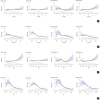Association of Lipids, Lipoproteins, and Apolipoproteins with Stroke Subtypes in an International Case Control Study (INTERSTROKE)
- PMID: 35677977
- PMCID: PMC9194539
- DOI: 10.5853/jos.2021.02152
Association of Lipids, Lipoproteins, and Apolipoproteins with Stroke Subtypes in an International Case Control Study (INTERSTROKE)
Abstract
Background and purpose: The association of dyslipidemia with stroke has been inconsistent, which may be due to differing associations within etiological stroke subtypes. We sought to determine the association of lipoproteins and apolipoproteins within stroke subtypes.
Methods: Standardized incident case-control STROKE study in 32 countries. Cases were patients with acute hospitalized first stroke, and matched by age, sex and site to controls. Concentrations of total cholesterol, high-density lipoprotein cholesterol (HDL-C), low-density lipoprotein cholesterol (LDL-C), apolipoprotein A1 (apoA1), and apoB were measured. Non-HDL-C was calculated. We estimated multivariable odds ratio (OR) and population attributable risk percentage (PAR%). Outcome measures were all stroke, ischemic stroke (and subtypes), and intracerebral hemorrhage (ICH).
Results: Our analysis included 11,898 matched case-control pairs; 77.3% with ischemic stroke and 22.7% with ICH. Increasing apoB (OR, 1.10; 95% confidence interval [CI], 1.06 to 1.14 per standard deviation [SD]) and LDL-C (OR, 1.06; 95% CI, 1.02 to 1.10 per SD) were associated with an increase in risk of ischemic stroke, but a reduced risk of ICH. Increased apoB was significantly associated with large vessel stroke (PAR 13.4%; 95% CI, 5.6 to 28.4) and stroke of undetermined cause. Higher HDL-C (OR, 0.75; 95% CI, 0.72 to 0.78 per SD) and apoA1 (OR, 0.63; 95% CI, 0.61 to 0.66 per SD) were associated with ischemic stroke (and subtypes). While increasing HDL-C was associated with an increased risk of ICH (OR, 1.20; 95% CI, 1.14 to 1.27 per SD), apoA1 was associated with a reduced risk (OR, 0.80; 95% CI, 0.75 to 0.85 per SD). ApoB/A1 (OR, 1.38; 95% CI, 1.32 to 1.44 per SD) had a stronger magnitude of association than the ratio of LDL-C/HDL-C (OR, 1.26; 95% CI, 1.21 to 1.31 per SD) with ischemic stroke (P<0.0001).
Conclusions: The pattern and magnitude of association of lipoproteins and apolipoproteins with stroke varies by etiological stroke subtype. While the directions of association for LDL, HDL, and apoB were opposing for ischemic stroke and ICH, apoA1 was associated with a reduction in both ischemic stroke and ICH. The ratio of apoB/A1 was the best lipid predictor of ischemic stroke risk.
Keywords: Apolipoproteins; Case-control; Dyslipidemia; Lipoproteins; Risk factor; Stroke.
Figures



Similar articles
-
ApoB and Non-HDL Cholesterol Versus LDL Cholesterol for Ischemic Stroke Risk.Ann Neurol. 2022 Sep;92(3):379-389. doi: 10.1002/ana.26425. Epub 2022 Jul 9. Ann Neurol. 2022. PMID: 35635038 Free PMC article.
-
The association of serum lipid level with ischemic stroke in the elderly of Xinjiang.Neuro Endocrinol Lett. 2019 Mar;39(8):572-578. Neuro Endocrinol Lett. 2019. PMID: 30927763
-
Lipids, lipoproteins, and apolipoproteins as risk markers of myocardial infarction in 52 countries (the INTERHEART study): a case-control study.Lancet. 2008 Jul 19;372(9634):224-33. doi: 10.1016/S0140-6736(08)61076-4. Lancet. 2008. PMID: 18640459
-
Pitavastatin: novel effects on lipid parameters.Atheroscler Suppl. 2011 Nov;12(3):277-84. doi: 10.1016/S1567-5688(11)70887-X. Atheroscler Suppl. 2011. PMID: 22152282 Review.
-
Meta-analysis of comparison of effectiveness of lowering apolipoprotein B versus low-density lipoprotein cholesterol and nonhigh-density lipoprotein cholesterol for cardiovascular risk reduction in randomized trials.Am J Cardiol. 2012 Nov 15;110(10):1468-76. doi: 10.1016/j.amjcard.2012.07.007. Epub 2012 Aug 17. Am J Cardiol. 2012. PMID: 22906895 Review.
Cited by
-
Cholesteryl Ester Transfer Protein Inhibition Reduces Major Adverse Cardiovascular Events by Lowering Apolipoprotein B Levels.Int J Mol Sci. 2022 Aug 20;23(16):9417. doi: 10.3390/ijms23169417. Int J Mol Sci. 2022. PMID: 36012684 Free PMC article. Review.
-
Differential distribution of plasma apoA-I and apoB levels and clinical significance of apoB/apoA-I ratio in ischemic stroke subtypes.Front Neurol. 2024 Jun 24;15:1398830. doi: 10.3389/fneur.2024.1398830. eCollection 2024. Front Neurol. 2024. PMID: 38978811 Free PMC article.
-
A potentially underestimated predictor of coronary artery disease risk: The ApoB/ApoA1 ratio.Heliyon. 2024 May 31;10(11):e32084. doi: 10.1016/j.heliyon.2024.e32084. eCollection 2024 Jun 15. Heliyon. 2024. PMID: 38873661 Free PMC article.
-
Low LDL-C/HDL-C Ratio is Associated with Poor Clinical Outcome After Intracerebral Hemorrhage: A Retrospective Analysis of Multicenter, Prospective Cohort Data in China.Neurocrit Care. 2024 Aug;41(1):29-37. doi: 10.1007/s12028-023-01905-z. Epub 2023 Dec 26. Neurocrit Care. 2024. PMID: 38148436
-
Circular RNAs in intracranial aneurysms: Emerging roles in pathogenesis, diagnosis and therapeutic intervention.Noncoding RNA Res. 2023 Nov 27;9(1):211-220. doi: 10.1016/j.ncrna.2023.11.012. eCollection 2024 Mar. Noncoding RNA Res. 2023. PMID: 38125753 Free PMC article. Review.
References
-
- Thrift AG. Cholesterol is associated with stroke, but is not a risk factor. Stroke. 2004;35:1524–1525. - PubMed
-
- Deedwania PC, Pedersen TR, DeMicco DA, Breazna A, Betteridge DJ, Hitman GA, et al. Differing predictive relationships between baseline LDL-C, systolic blood pressure, and cardiovascular outcomes. Int J Cardiol. 2016;222:548–556. - PubMed
-
- van den Berg MJ, van der Graaf Y, de Borst GJ, Kappelle LJ, Nathoe HM, Visseren FL, et al. Low-density lipoprotein cholesterol, non-high-density lipoprotein cholesterol, triglycerides, and apolipoprotein B and cardiovascular risk in patients with manifest arterial disease. Am J Cardiol. 2016;118:804–810. - PubMed
-
- Pérez de Isla L, Alonso R, Mata N, Saltijeral A, Muñiz O, Rubio-Marin P, et al. Coronary heart disease, peripheral arterial disease, and stroke in familial hypercholesterolaemia: insights from the SAFEHEART Registry (Spanish Familial Hypercholesterolaemia Cohort Study) Arterioscler Thromb Vasc Biol. 2016;36:2004–2010. - PubMed
-
- Ito T, Arima H, Fujiyoshi A, Miura K, Takashima N, Ohkubo T, et al. Relationship between non-high-density lipoprotein cholesterol and the long-term mortality of cardiovascular diseases: NIPPON DATA 90. Int J Cardiol. 2016;220:262–267. - PubMed
Grants and funding
LinkOut - more resources
Full Text Sources
Miscellaneous

